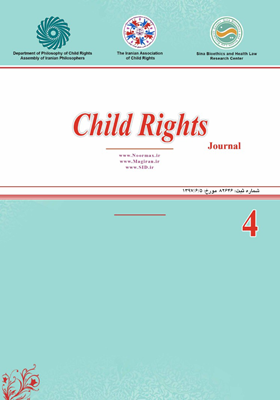Study of Social Rights and Rehabilitation of Children with Disabilities in International instruments and Iranian Laws
Subject Areas : child rightsManuchehr Tavassoli Naini 1 , Minou Tabatabaie 2 , Raheleh Jagir 3
1 - Associate Professor of Department of Law, Faculty of Administrative Sciences and Economics, University of Isfahan, Isfahan, Iran
2 - Assistant Professor of Educational Sciences, Depatrment of Educational Sciences, Payame Noor University, Fouladshahr, Iran
3 - Assistant Professor of Educational Sciences, Depatrment of Educational Sciences, Payame Noor University, Fouladshahr, Iran
Keywords: Persons with Disability, Social Rights, Equal Opportunity, Convention on the Rights of Persons with Disabilities, Standards Rules,
Abstract :
Attention to the issue of children with disabilities and the necessity of rehabilitation for regaining maximum possible extent of their abilities was initiated in the mid-19th century; this trend continued with ups and downs until attention to the rights of disabled persons reached its pinnacle at the beginning of the new millennium through the enactment of the Convention on the Rights of Disabled Persons in 2006. Meanwhile, the issue of social and rehabilitation rights of the Children with disabilities is also of utmost importance. One of the important issues that make social rights and rehabilitation of persons with disabilities more particularly relevant is the different circumstances in which the disabled are placed and throughout history this difference has caused them to be deprived of their rights. In the recent century, with condition of various laws, organizations in many countries and many international bodies have taken effective steps through legislation with respect to disability rights; and countries through adopting these laws, of which the Convention on the Rights of Persons with Disabilities is the most important; have accepted the rights of the disabled. However, it is noteworthy that the basis of this legislation and how to implement it is of utmost importance; whether the laws are implemented thoroughly or just being written on down. Unfortunately, the interval between codification of the law and its administration in developing countries such as Iran a huge gap is noticeable and there is a long way to go to meet the international standards.
1. United Nations ESCAP (Economic Social Commission for Asia and the Pacific. Disability at a Glance. Bangkok: ESCAP Publishing; 2012. p.1.
2. Handbook for Parliamentarians on the Convention on the Rights of Persons with Disabilities. Geneva: United Nations Publishing; 2007. p.1. Available at: https://www.un.org/development/desa/disabilities/ resources/handbook-for-parliamentarians-on-the-convention-on-the-rights-of-persons-with-disabilities.html.
3. Azarnoosh A. Arabic Dictionary of Contemporary Arabic-Persian Culture. 13th ed. Tehran: Ney Publication; 2011. [Persian]
4. Faraji MA. A Comparative Study of the Rights of the Disabled in the Field of Employment. Tehran: Jangal Publications; 2010. p.13. [Persian]
5. Bani Hashemi SA, Gholamzadeh SH. Education of Exceptional Children. 1st ed. Tehran: Payame Noor University Press; 2009. p.14-15. [Persian]
6. Available at: https://www.legifrance.gouv.fr/affichTexte.do?cid Texte=JORFTEXT000000809647.
7. Moradzadeh Rahmatabadi H. Civil Liability and Compensation. Ph.D. Thesis. Tehran: University of Tehran; 2000. p.250. [Persian]
8. Qari Seyed Fatemi SM. Discourse Transformation: "Rights and Freedoms of the Disabled in the Mirror of Contemporary Human Rights". Bi-Quarterly Journal of Legal Research 2008; 7(13): 188. [Persian]
9. Shafiabadi A. Vocational Rehabilitation of the Disabled. Tehran: Jangal Publications; 2003. p.10.
10. Hashemi SM. Fundamental Rights in the Islamic Republic of Iran. Principles and General Foundations of the System. 1st ed. Tehran: Shahid Beheshti University; 1995. Vol.1 p.72. [Persian]
11. Convention on the Rights of Persons with Disabilities (CRPD). Art.28. 1989. Available at: https://www.un.org/development/desa/ disabilities/convention-on-the-rights-of-persons-with-disabilities.html.
12. Available at: https://www.un.org/millenniumgoals/pdf/(2011_E) %20MDG%20Report%202011_Book%20LR.pdf. Accessed July 10, 2020.
13. Bakhtar SA. The Rights of Persons with Disabilities in Iranian Law. Tehran: Jangal Publications; 2009. p.56. [Persian]
14. Handbook for Parliamentarians on the Convention on the Rights of Persons with Disabilities and its Optional Protocol from exclusion to equality. Geneva: United Nations publishing; 2007. p.1. Available at: https://www.un.org/disabilities/documents/toolaction/ipuhb.pdf.
15. Lotfabadi H. Educational Psychology. 4th ed. Tehran: Samt; 2000. p.353. [Persian]
16. World Health Organization (WHO). Atlas Global Resources for Persons with Intellectual Disabilities. Geneva: World Health Organization Publishing; 2007. p.71. Available at: https://www. google.com/search?client=firefox-b-d&q=World+Health+Organizati on+%28WHO%29.+Atlas+Global+Resources+For+Persons+With+Intellectual+Disabilities%2C+2007. Accessed June 10, 2020.
17. Zames Fleisher D, Zames Fleisher F. The Disability Rights Movement. Philadelphia: Temple University Press; 2001. p.78.
18. Available at: https://en.unesco.org/themes/right-to-education/conv ention-against-discrimination.
19. Zamani SG. Simulation of Therapy and the Right to Health in the Realm of International Human Rights. Research in Law and Politics 2006; 4(19): 25-40. [Persian]
20. Disability and Millennium Development Goals, UN intonations. New York: United Nation Publishing; 2011. p.2. Available at https://www.un.org/disabilities/documents/review_of_disability_and_the_mdgs.pdf. Accessed June 10, 2020.
21. Durkin M. The epidemiology of developmental disabilities in low income countries, Mental Retardation and Developmental. Disabilities Research Reviews 2002; 3(8): 206-211.


